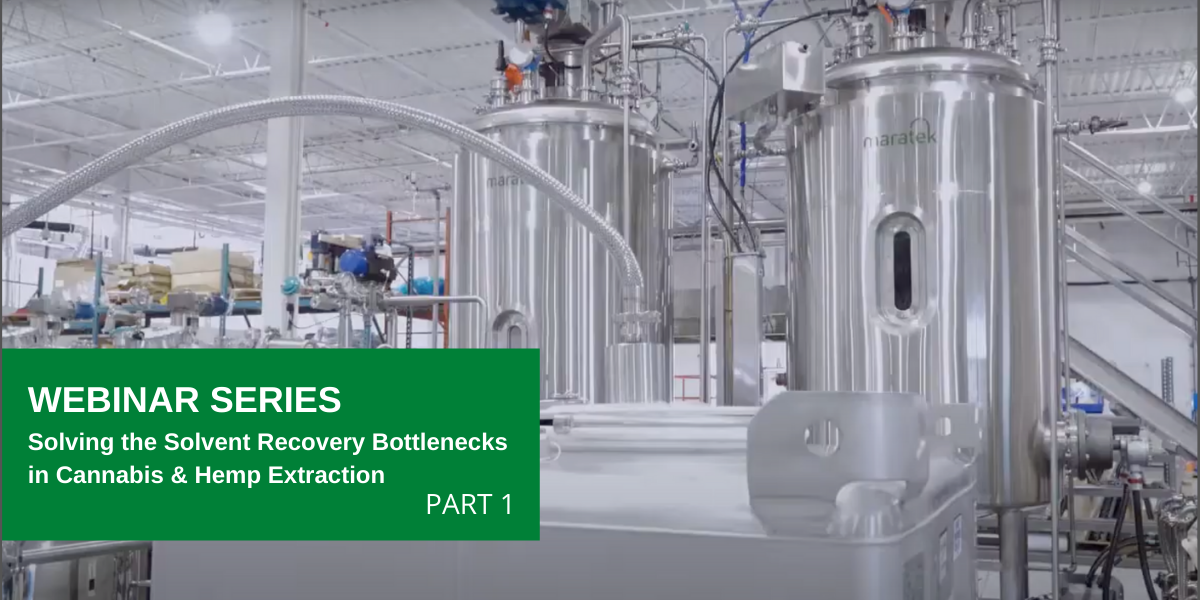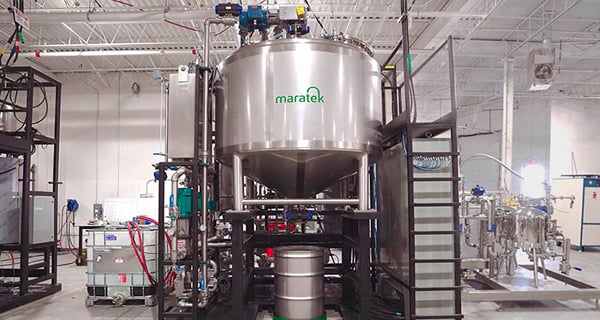Webinar #1: Scaling Cannabis and Hemp Oil Production

If you tuned into our first webinar, or read our two-part blog where we summarized what was discussed, we hope you learned some information about scaling up your cannabis and hemp extraction projects and how to get around some of the challenges involved.
In this next two-part blog on our second webinar, we will be taking a look at how you can solve the common solvent recovery bottlenecks that many people run into when scaling the technologies in their cannabis and hemp extraction operation - with a specific focus on how to deal with water buildup in the ethanol extraction process.
If you would like to watch the webinar in full, then please watch the embedded video below. Alternatively, you can read a summarised version of the webinar in the first and second part of this blog right here.
A quick summary of the cannabis and hemp extraction process
In our previous two blogs, and the first webinar, we dived into the extraction process as a whole. To summarize here, you have your biomass in feed and from there you add a solvent.
The most common two really in the industry right now are: cryo-ethanol and supercritical or subcritical CO2 extraction. From there, depending on the extraction process that you utilize, you might need to do a winterization step and that's to remove undesirables such as fats, waxes, lipids, chlorophylls and so forth. Then, a filtration process.
That’s where you start to get into the major area of bottlenecks and that's the bulk recovery stage - where you recover most of the solvent out of the ethanol, the residual recovery stage, followed by a decarboxylation step where we elevate temperature to activate the cannabinoids within the oil itself.
From there, we feed into a heated oil storage. Lastly, you could look to do downstream processing via distillate production, isolate production, THC remediation and whatever is really needed.
Why is solvent recovery a major bottleneck?
Solvent recovery bottlenecks are really the main bottlenecks every company runs into when scaling their cannabis and hemp extraction process.
The problem with the process right now is that a lot of people are looking at it as individual steps, individual processes and individual systems. We want to help people get out of the lab mindset and start thinking industrial.
The first system is for bulk recovery, getting most of the solvent out of the oil. There’s a secondary system, to get the residual ethanol out - ideally most of it - some still even leave some in. Which then goes into the decarboxylation step and any ethanol that you've left in now could be boiled off - and if you're just using it as a separate reactor you're going to be losing, which is another operational cost in your process.
Each of these steps is being done by different operators or one operator that is just operating one at a time, or can only oversee so many. So, at the end of every process there's a stop in the production.
This is the cause of why the whole solvent recovery and decarb step really has become a major bottleneck in the hemp and cannabis extraction process.
How Maratek’s unique extraction technologies solve these bottlenecks
Our focus and growth in the industry has been around solving this problem. This is where our unique Oil and Ethanol Recovery System (OERS) solution really comes into play. Please note that the system is not just for ethanol, we can incorporate and utilize it with a variety of solvents - if you're using pentane, hexane, heptane, whatever it is, not a problem for us.
The way we've designed our technologies and the way we've been planning and automating them is really a “set it and forget it” mindset. Someone would purchase one of these systems, set it to the side of their plan and it would really focus on automating their whole ethanol recovery stream - or whatever solvent they were recovering.
The real focus was around not needing to have an operator there 24/7. It could operate whether an operator is present or not. You don't need to worry about lots of costly maintenance and spare parts, they’re very efficiently built with very few moving parts.
Our aim with this technology is to turn bottlenecks into a production increase opportunity. Operators that have been operating numerous rotovaps, overseeing many falling film systems, taking it to the decarb reactors can now remove all those individual processes.
Residual solvents and decarboxylation explained
As I mentioned earlier, the OERS system can also incorporate decarboxylation. So, really what the oil and ethanol recovery system is, is a three-in-one solution.
You have your bulk recovery step, where 80 to 90 percent (averaging around 85) of ethanol is recovered out of your oil. Then, you have your final recovery, or residual recovery step, to recover the rest. Finally, you have your decarboxylation step.
With our OERS solution we can automate all three of these in one system, removing all that need. So, the way the system works is through a variety of phases:
# - Phase one
Your auto fill for the system, so it'll automatically fill the system and start to get to temperature.
#2 - Phase two
Is your auto top up phase. Now the system's actually reached the required temperature to recover the ethanol out of the system. We're operating under vacuum to keep temperatures low to avoid degradation of your oil, your terpene and also to reduce the amount of undesirables that come along with your ethanol stream. In phase two now what we're doing is we're automatically, continuously recovering your ethanol out of the system. We have our special demisters there to prevent oil entrainment within the ethanol vapors, which is then continuously condensed and discharged. Meanwhile, in this auto top-up phase, we're continuously auto topping up more of your oil and ethanol stream back into the still.
#3 - Phase three
This is our dry out or boil down phase and this is where we greatly differ from, for example, falling film technologies. This is where, in this step, we can bring you down to virtually zero percent ethanol. So we've turned off the auto top up and are focusing now on just getting every last drop of that residual ethanol out of your stream and that’s why we can guarantee virtually zero percent ethanol left at the end of this process.
#4 - Phase four
From there then, if you'd like, depending on your process, you might want to decarb. We could then program an automatic decarboxylation cycle where it goes to whatever temperature you'd like, for whatever period of time you'd like and whatever vacuum you'd like.
#5 - Phase five
Then phase five would be your cool down and automatic discharge. Now, as I did mention, we can provide a guarantee for your ethanol removal to virtually zero percent as well as for throughput. In fact, one of our clients here in Canada who's a major Canadian LP here in Ontario - they're a leading supplier, especially on vapes, to many provinces here - they're getting product off of one of our OERS lines there which is incorporated with our turnkey automatic winterization system. There’s zero ppm of ethanol in their oil.
OERS vs Falling film
A lot of people come to us and ask for a hundred gallon per hour solution or a 50 gram per hour solution, or so forth. You cannot use a general one-to-one comparison on there because on a falling film solution where you're recovering 10 gallons per hour, on us, when we say 10 gallons per hour, we're not talking about just doing a bulk recovery, we're talking about taking it down to virtually zero percent ethanol as well as decarbs.
So we're really looking at incorporating three steps into those fluid flow rates that we provide - compared to falling films' singular focus on bulk recovery.
Maratek’s patent-pending “end of decarboxylation sensor”
At the end of the decarb cycle, the way a lot of people do it right now is just visually looking at the bubbling of the oil and so forth. What our patent-pending process does is to automatically detect that endpoint.
Instead of decarbing and either visually doing it, or then testing it afterwards and saying: “Oh, it wasn't decarbed enough - it was only 98 percent decarbed!”, let's increase the temperature slightly, let's increase the duration slightly - we can automatically end that decarb point right there, thereby making your process even more efficient, and removing even further bottlenecks.
Maratek’s new four-in-one solution
One new feature that we have just released is an upgrade to our OERS three-in-one solution - with the launch of a brand-new four-in-one solution. This system really resonates with our Maratek F-series, our large-scale fractional distillation systems for in-line automatic ethanol reproofing.
It’s generally meant for streams where the ethanol has been already degraded to a significant standpoint and it does have quite a significant capital cost involved. Depending on your operation it might be the appropriate solution but, here what we're trying to do is provide a lower cost alternative with what we call “inline water diversion”.
What it's doing is help prevent the amount of water that'll be carrying on with your ethanol.
Ethanol contamination and discoloration
This is an issue we hear about a lot actually from groups that are looking to come in with our technologies for their existing operations. A lot of companies contact us and they have issues with green ethanol being recovered out, or orange, or yellow, or brown coloring - the green might be from chlorophyll - orange and yellow could be from oil entrainment or other variables.
A lot of this has to do with improper recovery settings: doing it at high temperatures, utilizing a system that requires constant supervision and constant tinkering, that can't think for itself or automate any of the process or put in fail-safes to ensure a clean and clear ethanol stream being recovered out, or also decarbing and doing the decarb step with residual solvents in it.
So, a few things here. This is where our Maratek demister solution really comes in to prevent that oil entrainment within the ethanol vapors to give you that clean, clear ethanol output but also, it's all about the real-time temperature and vacuum control features that we incorporate within our systems to really help give you an automated solution - to give you that crisp clean clear ethanol discharge.
One other feature that we have on OERS systems as well, is an automatic cooling jacket. For clients that are concerned about temperature spikes, it's another safety mechanism to help protect your oil.
Stay tuned for the second part of this blog, where we will summarise what was discussed in the second half of our webinar - looking at how water gets into your cannabis and hemp extraction process in more detail. If you have any questions, please feel free to contact us today.



